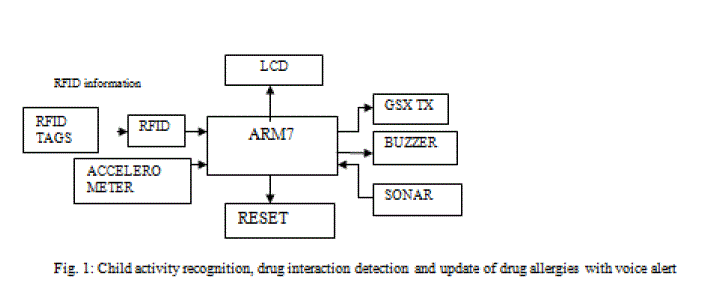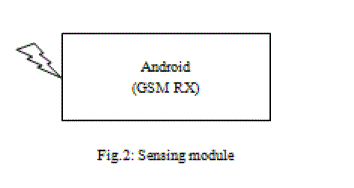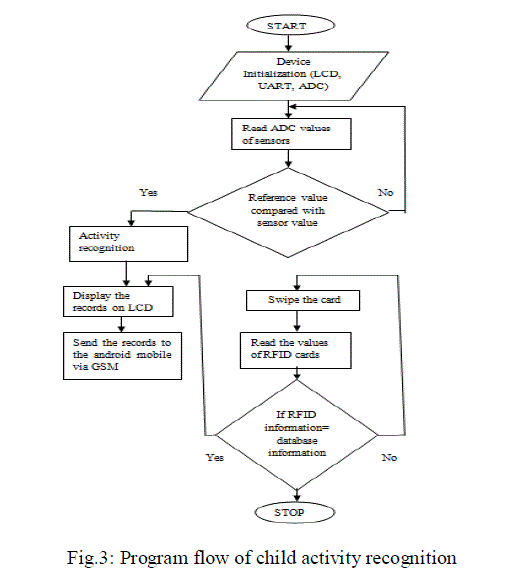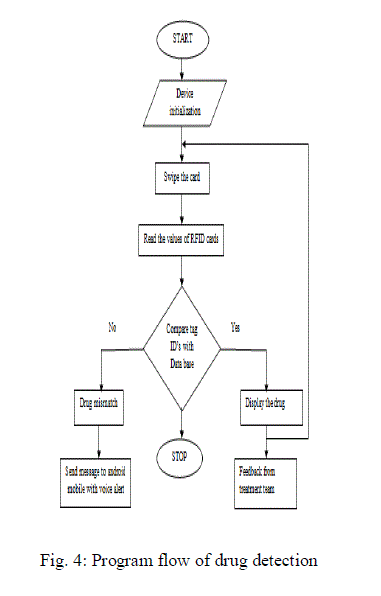ISSN ONLINE(2278-8875) PRINT (2320-3765)
ISSN ONLINE(2278-8875) PRINT (2320-3765)
Kushbu1, Mr.M.C.Chandrashekhar2, Dr. M.Z. Kurian3
|
| Related article at Pubmed, Scholar Google |
Visit for more related articles at International Journal of Advanced Research in Electrical, Electronics and Instrumentation Engineering
In this paper we describe the method of recognition of a child activity of both sexes up to the age of 16 to 29 months by using 3-axis accelerometer on a waist of the body to prevent child accidents such as unintentional injuries at home. Child activities are classified into 6 daily activities which are rolling, standing still, sitting down, walking, toddling, crawling. Medication errors are a leading cause of death worldwide hence hospitals are continuously trying to improve methods and strategies to prevent medication errors. NFC reader and an NFC application is used to detect and update drug allergies and drug interactions for people with multi-morbidity at the time of medication administration.
Keywords |
| Accelerometer, activity recognition, child care, wearable device, RFID. |
I.INTRODUCTION |
| Usually the babies of the age between 9 and 16 months starts walking and they are at a risk of falling down from stairs or furnitures. As toddlers will learn jumping and climbing they are at risk of falling from windows and beds. The major cause of injury in children are falling. Accident and emergency departments and outpatient surveillance systems have declared that falls are the major common mechanism of injuries that required a medical care. In children less than 4years most fall related injuries will occur at home. Hence to prevent child from home accidents a new safety management is required [1]. |
| Multi-channel accelerometry with calibrated sensors are very promising methodology have many advantages. The actual posture and the pattern of motion are basically provides a frame of reference for the evaluation of many behaviors, symptoms and physiological changes. The detection of body rotation may be important for more precise evaluation of nightly blood pressure changes since the blood pressure measurement refers to the level of the heart[2]. |
| Accelerometers are embedded within wrist bands, bracelets, adhesive patches and belts. The data from sensor is sent to mobile computing device through wireless communication. The computing device analyze the received signal and recognize the user activity. Activity recognition can be performed by collecting acceleration data from multiple locations on the body. In all previous works with multiple accelerometers have used accelerometers connected with wires, which may restrict object movement. Multiple sensors are more accurate for collecting different types of sensing information but it is very inconvenient for users. Hence only one single unit of sensor node is used, which collects multiple types of information[3]. |
| There are many ways to recognize the daily activities of people. One way to visually detect people’s movement by using cameras. The drawback of this solution is that recognizing of a moving person requires a large number of cameras which is of high cost. Another way by using personal companion devices such as mobile phones or watches with sensing and computing power to detect physical activities. |
| The watches are normally weared on the wrist. Hence the casual movement of arms doesn’t have a direct and obvious relationship with ongoing activities, also modern watches are not so powerful enough to perform the data processing. Therefore personal watches has a lot of constraints in detecting physical activities. Mobile phones are being more intelligent and powerful. When they are carried by people in pockets or bags, they are moving with the pace of the human body. Hence they appear to be the ideal platforms for detecting people’s physical activities such as sitting, walking, running and etc[4]. |
| Activity recognition by using accelerometers could improve the quality of care provided to patients and also used to observe the lifestyle and behaviour changes for healthy subjects. One limitation is that wearable accelerometers are difficult to predict which locations on the body can provide exact features with respect to activity classification. Another limitation is that single accelerometer cannot enough to provide sufficient contextual information and they need to be combined with other sensors such as microphones and ECG sensors to provide more accurate activity classification[5]. |
| Wearable devices are developed to objectively capture physical activity type, duration and intensity by analysing information on body movement. These tools are called activity monitors. Activity recognition has been focused on the use of inertial sensors, e.g. micro machined accelerometers used to measure body movements and to determine the activity type. These sensors are usually low power consumption and comparatively low cost of manufacture[6]. |
| Multi sensor are used to monitor daily life of elderly people and children at home. This approach is trained using manually annotated data and applied for activity recognition.A waist- worn sensor could fail to detect activities involving head motion, body tilt, and hand motion. Multiple sensors are used to improve the robustness of the systems and increase the reliability of the high-level decision making[7]. |
| Near Field Communication is a wireless connectivity technology that enables convenient short-range communication between electronic devices. NFC offers the best convenience for connecting all types of consumer devices and enables fast and easy communications.NFC acting as a secure gateway. NFC enabled mobile devices will allow consumers to store and access all kinds of personal data at home and even on the move. [8]. |
| Multi-morbidity patients who have more than one chronic disease for a long period of time has to take several medications at a time and they are more vulnerable to drug interactions and drug allergies. A novel solution using a smart phone integrated with an NFC reader and an NFC application is used to detect and update drug allergies and drug interactions for people with multi-morbidity at the time of medication administration. In some of the hospitals, the patients are requested to tie a ring on the wrist on which there is a barcode for identification. The parcel of drugs are printed with a barcode for description; these two mechanism are used to facility the matching between the drugs and patients. Hence the medical staff can easily execute the standard operation procedure (SOP) to confirm the right drugs being provided to the right patient. However, the bar code has some shortcomings such as it can be damaged and it contains fixed and limited information in which it cannot modify the contents according to the change of order. Radio Frequency Identification is an automatic identification technology. Its characteristics are precise and continuous automatic identification capability[9]. |
| The following methods are used to reduce and prevent patient misidentification[10]. Verbal and visual identification: Before performing a medical service patients are asked for their names as proof of identity and visually recognized by the medical staff. Chart-based identification: The medical staff uses the patient's medical chart to identify the patient. The medical staff checks the patient ID number and name from the medical chart to identify the patient before performing a medical service. |
| Hand-written wristband: This is one of the most common methods used in hospitals. In this method, the medical staff writes basic information of a patient on a plastic or paper-based wristband to identify the patient. However this approach has some drawbacks such as illegible hand writing and only limited information can be written on the wristband. |
| Barcode identification: This is the most commonly used method in hospitals. In this system, barcode wristbands and barcode scanners are used to identify patients. The use of barcode in the hospitals had a good degree of success in preventing misidentification and medical errors. However one of the main drawback against barcode is that once the information is provided it cannot be changed or updated and cannot provide up-to-date information in real time. Advanced identification technology: In many hospitals the new technology developments such as radio frequency identification, smart cards and biometrics are being considered to implement their patient identification schemes. If these technologies are implemented can provide more advanced services to track patient, billing and identification. |
| There are many types of medication errors which can occur in the medication administration such as drug allergy and drug interaction. Drug interactions and drug allergies will occur when the number of medications being administered increases. The patients having more than one chronic disease for a long period of time are used to take several medications at a time.By developing and managing an efficient health care system integrated with technology medication errors can be prevented. Several wireless technological applications have been developed to prevent medication errors.Near Field Communication technology is used to improve the quality of health care and increase patient safety. NFC is a short-range radio communication technology that operates on the 13.56 MHz frequency[11]. |
II.SYSTEM BLOCK DIAGRAM AND HARDWARE IMPLEMENTATION |
| The child activity recognition system, drug interaction detection and update of drug allergies with voice alert using ARM7 is explained in fig.1 |
 |
| The sensing module act as GSM receiver to getting messages to their care takers as shown in fig.2. |
 |
| ARM7 is the heart of the system which controls all the blocks shown in the fig.1. To observe the child and to show all the activities of the child in home, accelerometer and RFID card (NFC Cards) are attached. Where accelerometer detects child present and falling stages through its axis and RFID card will be read by RFID reader. Which will acts as near field communication. RFID card is attached to table or bulky items. Buzzer will be used which acts as an alarm and it is used to make sound when child come towards harmful objects. GSM is used for getting message to their parents/guardians for take care, where the parents/guardians mobile consists of android application to graph the child activities. The SONAR(Sound Navigation & Ranging) is used in this system to detect the bulky or huge materials in front of child and voice output will comes in android mobile. |
| A. Acccelerometer |
| ADXL335 is a complete 3-axis acceleration measurement system. The ADXL335 uses a single structure for showing the X, Y, and Z axes. As a result, the three axes shows directions. They are highly orthogonal and have little cross-axis sensitivity. |
| B. Sonar |
| Ultrasonic ranging module HC - SR04 provides 2cm - 400cm non-contact measurement function. The range of accuracy can reach to 3mm. The module contains ultrasonic transmitter, receiver and control circuit. |
| C. RFID |
| Radio-frequency identification (RFID) is an automatic identification method. RFID tags or transponders are used to store and retrieve data. The technology requires some extent of cooperation of an RFID reader and an RFID tag. An RFID tag can be used for identification and tracking purpose using radio waves RFID tag can be applied or incorporated into a products, animals, or peoples. Some tags can be read from several meters away and beyond the line of sight of the reader. |
| D. Buzzer |
| A piezo buzzer is driven by square waves (V p-p). A piezo buzzer can make higher Sound Output Level (SPL) with higher capacitance, but it consumes more electricity. The sound output is measured by decibel meter. Applying voltage and square waves, and the distance of 10 cm. A buzzer can make sound on any frequencies, keep working well between -30̢̮̉ and +70̢̮̉. |
| E. ARM7 |
| 1. It is 32-bit and single port device. IC voltage will vary from 1.8 to 3.3v. |
| 2. Low power consumption. |
| 3. 12v power supply. |
| 4. 12Mhz provided by crystal oscillator. |
| F. Android |
| 1. Android is a software stack used in mobile devices that includes an operating system, middleware and key applications. |
| 2. July 2005, Google acquired Android. |
| 3. November 2007, Open Handset Alliance formed to develop open standards for mobile devices. |
| 4. October 2008, Android available as open source. |
| G. GSM |
| Global System for Mobile communication (GSM) is a globally accepted standard for digital cellular communication. GSM has established in 1982 is the name of a standardization group to create a common European mobile telephone standard. AT Commands are used to get information in SIM card. |
| H. LCD (Liquid Crystal Display) |
| LCD is a thin and flat electronic visual display. A liquid crystal display uses the light modulating properties of Liquid Crystals (LCs). LCs does not emit light directly.LCD is a 2 line display each line consists of 16 pins. It has the operating voltage is 5v. LCDs uses very low power than the Cathode-Ray Tube (CRT) counterparts. LCDs use only atmosphere light to illuminate the display because they are ruminative. Even displays that do consume much less power than CRT devices require an external light source (i.e. computer displays). |
III. SOFTWARE IMPLEMENTATION |
 |
| Figure 3 shows the program flow, when setup is powered up, it initializes LCD, ADC, UART. Configure the ADC to read the data of sensors. The obtained ADC values are compared with reference values. If the obtained values are less than reference value then activity of child will be recognized. The activity of child can be extracted by swiping the RFID tag. When RFID is swiped the unique ID is sent to the controller. By processing the ID, the activity of child is displayed on LCD and also the records are sent to their parents via GSM. |
Results |
| Voltage values of sensors are noted in the table1. Depending on the values child activity will be recognized and displayed on LCD and also sent to their parents via GSM. |
 |
| Drug interaction detection |
| Figure 4 shows the program flow for drug detection. When setup is powered up, it initializes the devices. The detection of drugs can be extracted by swiping the RFID tag. When RFID is swiped the unique ID is sent to the controller. By processing the ID, the information of drugs are displayed on LCD and also the records are sent to their care takers via GSM. |
 |
| Results |
| The drug records are sent to the android mobile. If the drug is mismatched the message is sent to treatment team to their android mobile with voice alert through GSM. |
IV. APPLICATIONS |
| 1. Multi sensors are used to daily life monitoring for elderly people and children at home. |
| 2. Accelerometers are used to improve the quality of care for patients and to observe the child activities. |
| 3. NFC is used to increase patient safety. |
V. CONCLUSION |
| This paper proposes the activity recognition method for children, to prevent child accidents and prevention of drug allergies and drug interaction. Child activity can be performed by using a triaxial accelerometer which detects child present and falling stages through its axis. By using the accelerometer child activity is recognized and displayed on LCD and also sent to their parents via GSM. NFC technology can be used to improve the quality of health care and increase patient safety. Drug records are displayed on LCD if it is mismatched message will send to android mobile with voice alert. |
References |
|